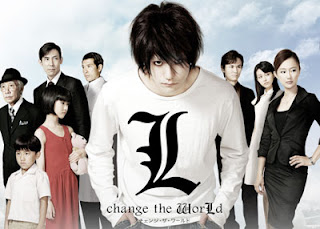Hell Girl (地獄少女 ,Jigoku Shōjo), also known as Jigoku Shoujo: Girl from Hell in Animax Asia's English-language television broadcasts,[citation needed] is an anime series, produced by Aniplex and Studio Deen. It premiered across Japan on numerous television stations, including Animax, Tokyo MX, MBS and others, between October 4, 2005 and April 4, 2006. Following t he success of the first season, the series was followed soon after into a second, Jigoku Shōjo Futakomori (地獄少女 二籠 ), which premiered October 7, 2006 across Japan on Animax.[citation needed] A live-action television series adaptation started airing in Japan on Nippon Television from November 4, 2006.[citation needed] A third season of the anime, further continuing the series, was first announced on the mobile version of the series' official website Jigoku Tsūshin.[1] The official title of the third season was announced to be Jigoku Shōjo Mitsuganae (地獄少女 三鼎 ).[2] and began airing on Japanese TV October 4, 2008.[3]
he success of the first season, the series was followed soon after into a second, Jigoku Shōjo Futakomori (地獄少女 二籠 ), which premiered October 7, 2006 across Japan on Animax.[citation needed] A live-action television series adaptation started airing in Japan on Nippon Television from November 4, 2006.[citation needed] A third season of the anime, further continuing the series, was first announced on the mobile version of the series' official website Jigoku Tsūshin.[1] The official title of the third season was announced to be Jigoku Shōjo Mitsuganae (地獄少女 三鼎 ).[2] and began airing on Japanese TV October 4, 2008.[3]
PLOT
Most episodes are self-contained short stories in which the series narrates the suffering of a different individual caused by one or more antagonists. In general during each arc, the protagonists' dramas are explained in detail from the start of their grudges, through the escalation of their torment until it becomes unbearable and they resort to accessing the Hell Correspondence website. Although in general, the client gives the antagonist a chance, he or she usually ends up pulling the string on his or her doll and sending the antagonist to hell. Once they have pulled the string
, before taking the antagonist to hell, Ai Enma punishes the person for his or her sins with the help of her companions.
In the first season, the story soon follows a journalist named Shibata Hajime, a former blackmailer, and his daughter Tsugumi who shares a strange connection with the Jigoku Shōjo as they investigate the truth behind the Jigoku Shōjo. In the second season, a mysterious young girl from Hell, named Kikuri is introduced who is able to travel freely between Earth and the Twilight realm where Ai resides. Later, the plot centers around Takuma Kurebayashi, a boy who is blamed by his townsfolk for causing disappearances around the town that are in reali ty caused by the townsfolk using the Hell Correspondence. In the third season, some time after Ai's death, Kikuri returns along with a yokai named Yamawaro, who accepts an old offer from Ai to become her fourth assistant. The story follows Ai mysteriously revival from death and subsequent inhabitation of the body of a young schoolgirl, Yuzuki Mikage.
ty caused by the townsfolk using the Hell Correspondence. In the third season, some time after Ai's death, Kikuri returns along with a yokai named Yamawaro, who accepts an old offer from Ai to become her fourth assistant. The story follows Ai mysteriously revival from death and subsequent inhabitation of the body of a young schoolgirl, Yuzuki Mikage.
The Summary for ep.1
A round ball of light bounces through the city, as various events occur aro
und the Jigoku Tsushin. Ren sees a strange boy appear before him in a bathhouse, Kikuri reappears before Wanyudo, and Hone sees a vision of Ai when a butterfly lands in front of her in a bar. At a certain school later, three girls get into trouble with their teacher Tange when he finds out that they are passing notes. Having heard bad rumors about Tange, the girl named Itsuka later suggests that they need to take measures against him for their futures. Because of her father’s influence, the girl named Akie is given responsibility for dealing with most of this. As Kikuri returns to the Jigoku Tsushin with him in the meantime, the young boy from earlier is revealed to be named Yamawaro. He address Kikuri as “hime” while he assists with her childish desires. Mikage Yuzuki, one of the girls from earlier, sees a strange vision while in the bath that night. Ai appears out of the water, dragging her into it and sharing a kiss with her. Yuzuki puts this off as a dream afterwards, but unknown to her, a butterfly has wrapped around her back.
young boy from earlier is revealed to be named Yamawaro. He address Kikuri as “hime” while he assists with her childish desires. Mikage Yuzuki, one of the girls from earlier, sees a strange vision while in the bath that night. Ai appears out of the water, dragging her into it and sharing a kiss with her. Yuzuki puts this off as a dream afterwards, but unknown to her, a butterfly has wrapped around her back.
The next day, Akie re
veals that her father could not do anything because of the lack of proof against Tange. She doesn’t believe him to be a bad person either, so she leaves the other two girls without much thought. Itsuka still believes their situation is serious, however, so she convinces Yuzuki to accompany her in creating evidence against Tange. The two girls go to a love hotel that night, as Itsuka plans to take a picture of Tange when he passes. Yuzuki successfully shoots when Itsuka approaches who she believes is Tange, but this ironically turns out to be her father. With this, both of Itsuka’s parents appear in wonder of what she is doing in such a place. This brings Itsuka to the Jigoku Tsushin website that night, where she types in Tange’s name. Itsuka meets Ai as expected, who presents her with a doll that has a red string wrapped around it. She explains that by pulling the string, her enemy would be sent to hell. However, she would also follow after she died. Itsuka cannot believe these circumstances, but she reappears in her room with the doll before she can say any more. Yuzuki wakes from this vision, believing it to be another dream, but Ai appears to tell her that she is actually inside of her.
Itsuka continues to act rebellious at school the next day, even listening to her mp3 player in class. When Tange takes this from her, she runs out of the classroom in rage. While she looks through several places that afternoon in search for her mp3 player, T
ange appears to tell her that he has already cast it aside. Itsuka reveals what she has heard about Tange refusing to pass students that he does not like, guessing that he plans to do the same to her. Tange states that this is impossible, but Itsuka brings out her doll before he can suggest anything else. Yuzuki appears just in time to see Itsuka pull the string, then feeling pain as Ai bursts from her body. With this, the Jigoku Tsushin appear to torture Tange and bring him to hell. When Yuzuki reappears in her reality, she finds that Itsuka has a round mark below her neck. When Akie shows up as well, however, she reveals that Tange had given her Itsuka’s mp3 player to return. Further more, there are doodles in the notebook Tange always seemed to write bad notes into. In the end, Tange really wasn’t a bad person.
Hell Correspondence
The medium through which a client contacts Ai Enma has changed over the centuries. Initially clients would write the names of that whom they hated in a three-column newspaper advertisment. After which, clients could enter names into a BBS that was programmed in BASIC. When the internet became available, people access the a website known as the "Hell Correspondence" (地獄通信 ,Jigoku Tsūshin) or the "Hotline to Hell". Soon after, the site was adapted into a mobile version that could be accessed from cell phones.[4]
Each medium can only be used at midnight by one who harbors a desire for revenge against their object of hatred. Should someone submit the name of someone against whom they bear a grudge or immense hatred, the Ai Enma will take them to a realm of

perpetual twilight where she offers them a straw doll, one of her companions, with a red string wound around its neck and describe to the client the details of their contract; should the client pull the string the tied around the doll's neck, she will ferry the target of the revenge straightaway to Hell. However, once the client's life has ended, he or she will too go Hell; a black crest-shaped mark appears on the client's chest to serve as a permanent reminder of this and their decision to send someone to Hell.
You can Watch jigoku Shoujo Mitsuganae on AnimeCrazy.Net here's the Playlist of episode
http://www.animecrazy.net/category/more-running-anime/jigoku-shoujo-mitsuganae/  n 1999 with the short lived Korean boy band, A4. He left after the band's first album debut, citing musical differences between himself and the other members of the band. After being released from A4, he signed onto M Boat, a former sister company to YG Entertainment. He underwent a few years of vocal training under the label and released his first solo album Like A Movie in 2002. The album became very popular after receiving praise from many well-known artists, including Seo Taiji and Shin Seung Hun. In 2003, he released his second album, It's Real. It proved to be as popular as his first, making him the best selling artist of 2003 in Korea. Unlike his debut album, It's Real wasn't restricted to R&B and it included different musical elements like pop and hip-hop. Wheesung left YG Entertainment after his contract expired in March 2006. He signed a new contract that is reportedly worth 1.5 million won with his new company Orange Shock Agency. It was stated that he will be composing and producing more with his new company giving him more freedom to do so.
n 1999 with the short lived Korean boy band, A4. He left after the band's first album debut, citing musical differences between himself and the other members of the band. After being released from A4, he signed onto M Boat, a former sister company to YG Entertainment. He underwent a few years of vocal training under the label and released his first solo album Like A Movie in 2002. The album became very popular after receiving praise from many well-known artists, including Seo Taiji and Shin Seung Hun. In 2003, he released his second album, It's Real. It proved to be as popular as his first, making him the best selling artist of 2003 in Korea. Unlike his debut album, It's Real wasn't restricted to R&B and it included different musical elements like pop and hip-hop. Wheesung left YG Entertainment after his contract expired in March 2006. He signed a new contract that is reportedly worth 1.5 million won with his new company Orange Shock Agency. It was stated that he will be composing and producing more with his new company giving him more freedom to do so.
_vol01.jpg)









__THISRES__213263.jpg)






















